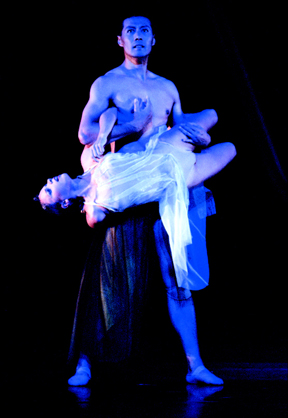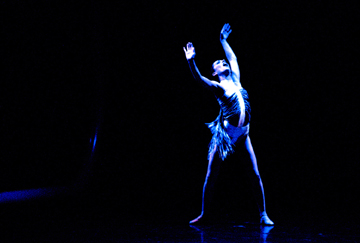Pushing It
Ellipse
Sydney Dance Company
Joyce Theater
New York, NY
February 19, 2004
by
Susan Reiter
copyright
© 2004 by Susan Reiter
published February 23, 2004
 The
gentle swaying of a glowing oblong red lantern, as it rose slowly through
the darkness up to the flies, was the opening image of Graeme Murphy's
Ellipse. The introductory section, for two women who shared a
mysterious symbiotic connection, was a bravely reflective and somber one.
But as it progressed through its 80 minutes, Ellipse evolved
into a rough-and-tumble agglomeration of teasingly tasteless costumes,
excessive gymnastic exploits, and attempts at humor that veered too close
to silliness.
The
gentle swaying of a glowing oblong red lantern, as it rose slowly through
the darkness up to the flies, was the opening image of Graeme Murphy's
Ellipse. The introductory section, for two women who shared a
mysterious symbiotic connection, was a bravely reflective and somber one.
But as it progressed through its 80 minutes, Ellipse evolved
into a rough-and-tumble agglomeration of teasingly tasteless costumes,
excessive gymnastic exploits, and attempts at humor that veered too close
to silliness.
A seven-part exploration of the music of Australian composer Matthew Hindson, this 2002 dance is one of Murphy's non-narrative works. It followed his Tivoli, an elaborate spectacle evoking a forgotten era of vaudeville-style touring entertainments that was performed jointly by Murphy's Sydney Dance Company and the Australian Ballet, and it preceded the version of Swan Lake he staged for the ballet troupe. One might expect that with Ellipse he had a chance to clear his palate between the rich meals of two such theatrical projects—an opportunity to savor the direct connections between music and dance.
Hindson's music is contemporary classical fare with an intriguingly wide range, judging from this sampler. Some is spare and melancholy, while at times it sounds like John Adams or ventures more towards movie-soundtrack grandiosity. He seems particularly fascinated by the possibilities of stringed instruments, mining the sonorous depths of the cello and the edgy, gracing possibilities of the violin.
Murphy re-teamed with several designers with whom he had worked on other recent dances. Gerard Manion contributed an imposing set of continuous pipe-like silver tubing, which both framed and engaged the stage. At times, dancers leaned or reclined on it, and its volume and curved corners made it a very active part of the proceedings—far more than just background.
 The
imaginative but overly busy costumes by Akira Isogawa became such a dominant
element that they frequently distracted from the choreography. The basic
look was trunks or skimpy leotards, or dance belts with stylized codpieces,
with partial skirts of gossamer floaty fabric, or tufts of fringe, attached.
Much of the time, the men—many of whom are large and beefy—reminded
me of the Graham company at the height of the Halston era. Rumps and thighs
were exposed and emphasized, and the whole look grew tacky. Several of
the largest men wore these dance belts along with what one Australian
critic identified as "micro boleros" —I borrow this term
because I was at a loss at what to call these items, which covered the
arms and shoulders (in chartreuse or blazing orange) while exposing the
chest. Isogawa employs a fascinating array of prints and textures in the
swatches of wispy material that drape around or trail form, the dancers'
bodies, but it is al too much—and in many cases, it cuts or distorts
the bodies unflatteringly.
The
imaginative but overly busy costumes by Akira Isogawa became such a dominant
element that they frequently distracted from the choreography. The basic
look was trunks or skimpy leotards, or dance belts with stylized codpieces,
with partial skirts of gossamer floaty fabric, or tufts of fringe, attached.
Much of the time, the men—many of whom are large and beefy—reminded
me of the Graham company at the height of the Halston era. Rumps and thighs
were exposed and emphasized, and the whole look grew tacky. Several of
the largest men wore these dance belts along with what one Australian
critic identified as "micro boleros" —I borrow this term
because I was at a loss at what to call these items, which covered the
arms and shoulders (in chartreuse or blazing orange) while exposing the
chest. Isogawa employs a fascinating array of prints and textures in the
swatches of wispy material that drape around or trail form, the dancers'
bodies, but it is al too much—and in many cases, it cuts or distorts
the bodies unflatteringly.
Choreographically, Ellipse was a case of diminishing returns. In the opening "Lament," the isolated, ruminative figure of Wakako Asano was shadowed and then joined by Katherine Griffiths. The women then engaged in gently exploratory partnering, exchanged cantilevered moves and acting protectively towards one another. With the entrance of imposing, hulking Simon Turner, who moved stiffly and held his arms stiffly angled like the minotaur figure in Graham's Errand into the Maze, the atmosphere (and the music) became more melodramatic. He partners them both, but in the end this vignette is about the women, as Asano is left yearning for the retreating Griffiths.
As Ellipse progressed, there was less and less subtlety, and more straining for effects. The SDC dancers are an athletic, ready-for-anything bunch, ready to contort with yogic abandon, throw themselves at each other and get borne aloft in a dazzling variety of ways. But too much of what Murphy has created here looked contrived—especially his efforts at humor (a pseudo-hoedown and an embarrassing portrayal of goofy cowboys and the Perils-of-Pauline rescue of a damsel tied to the railroad tracks. The final section, to an overextended and shapeless Hindson composition titled "Speed," alternated hectic, souped-up techno-flavored orchestral passages with extenuated, shapeless, melodramatic ones. The section seemed to end at least five times, and one sensed an increasing desperation as Murphy strived to come up with enough movement to fill out all its aimless twists and turns. It finally wore itself out rather than coming to a close.
Originally
published:
www.danceviewtimes.com
Volume 2, Number 8
February 23, 2004
Copyright
©2004 by Susan Reiter
|
|